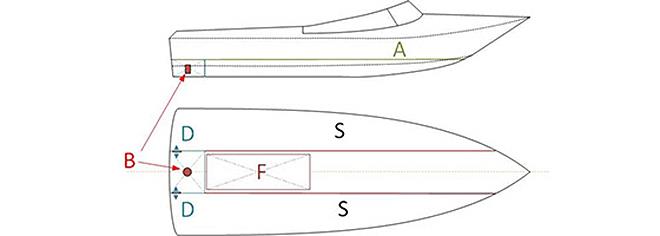
Safety Warning: Check your sealed decks
by Maritime Safety Victoria 28 Mar 2019 09:29 GMT

Diagram showing a profile and underdeck example - A: Sealed deck, B: Bilge pump, D: Drain, F: Fuel tank, S: Sealed compartments © Maritime Safety Victoria
Maritime Safety Victoria (MSV) technical experts outline the features of sealed decks and how they should work. If you have a small boat with a deck that is intended to be watertight, there are a number of issues to look out for.
MSV has inspected a number of vessels recently in the 4-7m length range which are supposed to have sealed decks.
A vessel with a sealed deck typically has the following features:
- A number of watertight compartments in the vessel hull under the sealed deck, sometimes filled with buoyancy material such as buoyancy foam.
- Access to these compartments for inspection purposes which are fitted flush to the deck. These are often 'spinouts' and must be watertight preventing water from entering the compartments.
- Sealed deck penetrations carrying cables, fuel systems hoses, wiring etc or deck penetrations with openings high up under the gunwales.
- A sump (usually aft) where deck water can collect and be removed using a pump.
- A pump or pumps used to remove water from the sump. Can be a marine hand pump but is commonly a 12-volt electric pump.
- A means to activate the bilge pump, usually a float switch is fitted in the sump which is lifted when water is present which turns on the pump.
- The float switch may be connected to an audible bilge level alarm located at the helm, so the owner is aware of water in the sump and that the pump is operating.
- Vessels with sealed decks are usually a step up in size from a 'tinny' and often have a fixed underdeck fuel tank which has a watertight deck panel fitted above it.
- Decks are sometimes higher than the external sea level. To assist in draining the deck, drainage holes or 'scuppers' are often fitted at deck level through the transom. These are often fitted with flaps which close to prevent water entering the vessel in rougher seas.
- Drainage holes in the bottom of the vessel are sealed with bungs to drain any water which finds its way into the underdeck compartments. These are screwed in prior to the vessel being launched from its trailer and removed when the vessel is retrieved.
Typically an incident occurs where water collects out of sight of a sealed deck that has failed. The consequences are serious - with outcomes including flooding, capsizing and sinking with potential fatalities.
For the sealed deck to work properly, all of the above are designed to work together to keep a vessel safe. Each item must be maintained in good condition.
The inspected vessels all had one or more failures in these systems.
The chronology of failures and their causes is often very similar and goes something like this:
1. Vessel takes on water, due to:
a. Vessel leaking, because of hull structural failure
b. Water entering below deck compartments, because of water being taken on deck due to waves, spray, rain and deck structural failure and/or failure of watertight spinouts and/or failure of fuel tank soft patches and/or unsealed deck penetrations for wiring, cables etc.
2. Crew not being able to remove water, due to:
a. Not knowing water was entering vessel, because of no operating bilge pump alarm
b. Water not being able to be removed, because of no working pump, or no working float switch to operate pump, or sump or bilge access too small to allow removal of water by bailer or bucket.
3. Vessel capsizes, due to:
a. Water in hull(s) and on deck, because sufficient water has entered to increase mass of boat for freeboard to be lost, and/or insufficient flotation to support increased mass, and/or water in compartments, tanks and on deck creates sloshing water surfaces which reduce stability
4. Vessel floats in a poor attitude or sinks, due to:
a. Amount and position of flotation materials will determine what happens to vessel - check your Australian Builders Plate. Note that a vessel with 'level' flotation performs best, by staying as upright as possible.